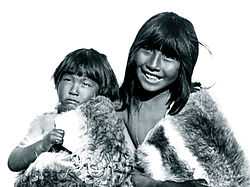Selknam Genocide
| Part of a series on |
| Genocide of Indigenous peoples |
|---|
| Issues |
|
| Documented instances |
|
| Related topics |

The Selknam Genocide was the genocide of the Selk'nam people, indigenous inhabitants of Tierra del Fuego in South America, from the second half of the 19th to the early 20th century.
History

The Selknam, also known as the 'Ona, were an indigenous people who inhabited the northeastern part of the archipelago of Tierra del Fuego for thousands of years before Europeans arrived. They were nomads known as "foot-people," as they did their hunting on land, rather than being seafarers.
The last full-blooded Selk'nam, Angela Loij, died in 1974. They were one of the last aboriginal groups in South America to be reached by Europeans. Their language, believed to be part of the Chonan family, is considered extinct as the last speakers died in the 1980s.
The Selk'nam had lived for thousands of years of semi-nomadic life in Isla Grande de Tierra del Fuego (literally, "big island of land of fire;" its name was based on early Spanish explorers' observations of smoke from Selk'nam bonfires.) They lived in the northeast, with the Haush people to their east on the Mitre Peninsula, and the Yahgan to the west and south, in the central part of the main island and throughout southern islands of the archipelago.
In the 1880s, Europeans introduced sheep ranches to the large open areas of Tierra del Fuego. Numerous European immigrants arrived to work in the new industry. The ranches created strong conflicts with the Selk'nam natives, who had traditionally hunted this territory and considered the sheep game. They had no concept of European property rights. The large ranchers tried to run off the Selk'nam, then began a campaign of extermination against them, with the compliance of the Argentine and Chilean governments. Large companies paid sheep farmers or militia one pound sterling per Selk'nam dead, which was confirmed by the redemption of a pair of hands or ears, or later a complete skull.
Repression against the Selk'nam persisted into the early twentieth century.[1] Chile moved some Selk'nam to Dawson Island, confining them in an internment or concentration camp. Argentina finally allowed Salesian missionaries to aid the Selk'nam and attempt to assimilate them, but their culture and people were largely destroyed.
Ángela Loij, the last full-blooded Selk'nam, died in 1974. According to the 2010 United Nations Educational, Scientific and Cultural Organization (UNESCO) Atlas of the World's Languages in Danger, the Ona language is extinct, as the last speakers died in the 1980s.[1]
Footnotes
See also
- Julius Popper
- Tierra del Fuego Gold Rush
- Fuegians
References
- Adelaar, Willem (2010). "South America". In Christopher (ed.), Atlas of the World's Languages in Danger, 3rd Edition. UNESCO. pp. 86–94.
Further reading
- Luis Alberto Borrero, Los Selk'nam (Onas), Galerna, Buenos Aires 2007.
- Lucas Bridges, Uttermost Part of the Earth, London 1948.
External links
| Wikimedia Commons has media related to Selknam Genocide. |